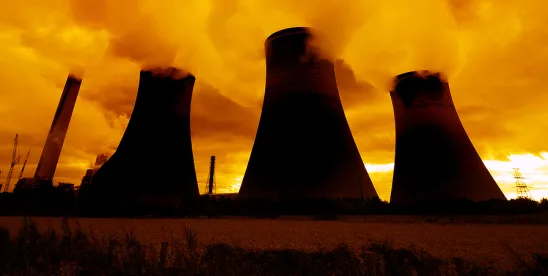In 2025, U.S. nuclear energy is experiencing a marked resurgence, fueled by executive reforms, legislative backing, rising tech-sector demand and reactor innovation. Both conventional and advanced modular technologies are gaining traction, while nuclear's potential is expanding into space exploration and alternative energy industries.
A Renaissance in Policy and Regulation
The foundations of the 2025 U.S. nuclear revival lie in a combination of regulatory streamlining and executive orders that have prioritized nuclear energy as a key pillar of national policy. The Accelerating Deployment of Versatile, Advanced Nuclear for Clean Energy Act (ADVANCE Act) enacted in July 2024 and assertively implemented this year, has proven transformative. The law mandates the Nuclear Regulatory Commission (NRC) to modernize its licensing process, reduce fees and facilitate advanced reactor deployment, particularly at brownfield and former fossil fuel sites.
The current administration issued a series of executive orders in May 2025 that significantly altered the approval landscape to facilitate implementation of the ADVANCE Act, including:
- Executive Order 14301: Reforming Nuclear Reactor Testing at the Department of Energy
- Executive Order 14299: Deploying Advanced Nuclear Reactor Technologies for National Security
Under these directives, the Department of Energy (DOE) and Department of Defense (DOD) gained authority to conduct reactor design reviews whose findings are presumptively binding on the NRC, unless explicit safety objections arise. Critics argue this compromises NRC independence and raises concerns of regulatory capture by the nuclear industry, while proponents see it as a necessary acceleration to meet growing electricity demand and global competitiveness.
Surge in Advanced Reactor Development
This regulatory support has translated into real-world momentum for several reactor designs. NuScale Power achieved a key milestone in May when its updated 77 MWe small modular reactor (SMR) received standard design approval from the NRC. This marks the first such approval in years and positions NuScale as a potential leader in scalable nuclear deployment.
Also in May, Kairos Power commenced construction of the Hermes Low-Power Demonstration Reactor in Tennessee. The company’s use of molten salt coolant and pebble-fuel technology offers an alternative to conventional water-cooled systems, with enhanced safety and thermal efficiency. Kairos' strategic partnership with Google — which aims to power AI data centers with a 500 MW fleet of SMRs — has further elevated its visibility and commercial prospects.
Terrestrial Energy also made headlines in 2025, launching a $280 million SPAC deal to become the first nuclear molten salt reactor company to go public and reaching a siting agreement with Texas A&M University for its Integral Molten Salt Reactor (IMSR). The reactor's ability to operate at higher temperatures and provide industrial heat in addition to power production may help it secure a foothold in decarbonizing heavy industry.
Private Sector Investment and the AI Catalyst
Beyond policy, one of the defining drivers of the nuclear revival in 2025 has been the private sector — especially the tech industry. In a shift that would have seemed improbable just a few years ago, cloud and artificial intelligence (AI) giants have emerged as major nuclear advocates and investors.
Amazon’s Climate Pledge Fund led a $500 million investment in X-energy to support advanced small modular nuclear reactors and expand carbon-free power. The investment targets up to 5 GW of new nuclear capacity to support AI and cloud computing demands. Meta issued a request for proposals for four GW of new nuclear power to help meet AI and sustainability objectives. These moves reflect a broader trend among energy-intensive tech companies recognizing that nuclear is one of the few scalable, dispatchable clean energy sources capable of supporting massive computer workloads.
Perhaps the most ambitious new project to date is the Fermi America “Hypergrid” outside Amarillo, Texas, announced in July 2025 in collaboration with the Texas Tech University System. This planned 5,800-acre clean energy park will co-locate 4.4 GW of nuclear capacity — including AP1000 light-water reactors and future SMRs — with solar, battery storage and natural gas backup. The site is being designed specifically to host AI data center clusters, with 1 GW of nuclear targeted for deployment by 2026. The project is backed by recent Texas legislation (House Bill 14) that dedicates $350 million to advanced nuclear development and establishes the Texas Advanced Nuclear Energy Office.
Reviving Legacy Sites and Reactors
2025 has also witnessed renewed interest in previously shuttered or stalled nuclear assets. Holtec International, for instance, is leading efforts to restart the Palisades Nuclear Plant, a nuclear plant in Michigan that was retired in 2022. With $1.8 billion in combined funding from the DOE and state funding, the plant is expected to resume operations in 2026. Holtec also plans to deploy its SMR-300 reactor design at the same site by 2030, creating a unique hybrid of legacy and next-generation infrastructure.
Similarly, Santee Cooper and other stakeholders in South Carolina have revived discussions about acquiring and finishing V.C. Summer Nuclear Station Units 2 and 3. These Westinghouse AP1000 reactors were abandoned in 2017 due to cost overruns and mismanagement. However, with renewed federal interest, improved construction practices, and the influence of tech sector demand, completing the units is now seen as viable.
In perhaps the most creative crossover of resurrecting the old and using it to power new cutting edge AI development, Microsoft and Constellation announced an agreement in September 2024 “to reopen the Three Mile Island Unit 1 nuclear reactor, adding a new source of carbon-free electricity to offset the power demands of Microsoft’s expanding network of data centers.” Microsoft agreed to a 20-year supply agreement, with the parties aiming to have Unit 1 ready to restart in 2028, after repairs, renovation and NRC approval.
New Projects and Initiatives
In addition to ongoing efforts, several new nuclear projects and initiatives gained momentum in 2025:
- TerraPower’s Natrium Demonstration Reactor (Wyoming): In January 2025, the 345 MWe sodium-cooled Natrium reactor, with integrated molten salt energy storage, received State approval of construction permits. Backed by DOE and private funding, it aims to begin operation by 2030.
- Project Pele Mobile Microreactor (Department of Defense/BWX Technologies): In August 2025, BWX Technologies started fabricating the core for a 1.5 MW TRISO-fueled microreactor for military and remote use, targeting operation for 2028.
- Oklo’s Aurora Microreactor (Eielson Air Force Base, Alaska): Selected by the U.S. Air Force, this1-2 MW microreactor will support energy resilience at Eielson Air Force Base under a 30-year agreement.
- TVA & GE Hitachi’s BWRX‑300 (Clinch River, Tennessee): In May 2025 TVA submitted a construction permit application for the first U.S. deployment of GEH’s 300 MWe BWRX‑300 SMR. Licensing is underway with federal support.
- New York Power Authority SMR Directive: In June 2025, Governor Hochul directed the New York Power Authority to develop a zero-emission advanced nuclear energy technology power plan to develop a zero-emission nuclear project — the state’s first in over 15 years.
- DOE Fuel Line Pilot Program: On August 4, DOE selected Standard Nuclear selected Standard Nuclear for the first pilot project in the fuel line pilot program, announced in June 2025. The initiative, issued pursuant to the Executive Order 14299, is intended to eliminate America’s reliance on foreign sources of enriched uranium. Standard Nuclear will pioneer advanced fuel production in Tennessee to support emerging HALEU-based designs (high-assay, low-enriched uranium).
These projects underscore a broadened scope of nuclear development: from utility-scale and military deployments to regional power authority innovation and supply chain investments.
New Frontiers
Beyond grid power, nuclear technology is finding new applications that expand its strategic importance. On August 4, Politico reported that the Department of Transportation is issuing a directive to NASA to expedite formal plans to solicit industry proposals to deploy a 100-KW reactor on the Moon by 2030. The project is designed to provide surface power for future lunar bases and pave the way for eventual Mars missions. While the plan is optimistically ambitious, it faces a number of hurdles, including technical and engineering feasibility, budgetary and manpower constraints, and regulatory hurdles notwithstanding the favorable new policies.
State-Level Policy Acceleration
While federal policy sets the tone, states are increasingly active in promoting nuclear development. Texas, Michigan, Indiana, Utah, Arizona and Tennessee have introduced new laws to facilitate SMR siting, provide financial incentives and coordinate permitting. Tennessee, already home to Kairos Power's demonstration site, is positioning itself as a national hub for advanced reactor development.
These state-level initiatives are often framed as economic development strategies as well as decarbonization tools. SMRs offer a compelling opportunity to optimize grid connections, retain skilled labor and stimulate rural economies.
Challenges and Cautionary Notes
Despite strong tailwinds, challenges remain. Critics warn that pressure on the NRC to expedite approvals could compromise long-term safety. Environmental and nonproliferation groups continue to raise concerns over spent fuel management, proliferation risks and the potential for cost overruns.
Cost and timeline uncertainties also linger. While SMRs promise lower capital costs and faster builds, few have reached commercial scale. The cancellation of NuScale’s Carbon Free Nuclear Power Project in 2023 due to rising costs still casts a long shadow. Whether the new wave of reactors can deliver on time and on budget remains to be seen.
Supply chain constraints — from enriched fuel to specialized manufacturing components — pose additional risks. The U.S. currently lacks sufficient capacity for HALEU, which many advanced reactors require. Investments in domestic enrichment facilities are underway, but bottlenecks may slow deployment. Successful implementation of the DOE’s fuel line pilot program to develop or build and operate nuclear fuel lines will be critical to increasing nuclear power production capacity.
Conclusion
2025 has been a pivotal year for U.S. nuclear power. Legislative reforms, executive action, and an unprecedented wave of private investment have reignited momentum for both conventional and advanced nuclear energy. From restarting shuttered plants to siting next-generation reactors at data center campuses and even on the Moon, the range of applications is rapidly expanding.
Ultimately, success will depend on execution. Maintaining safety standards, delivering projects on schedule, and building public trust are essential. If the U.S. nuclear industry can navigate these hurdles, 2025 may come to be remembered not just as a turning point, but as the beginning of a sustained nuclear revival.




 />i
/>i

